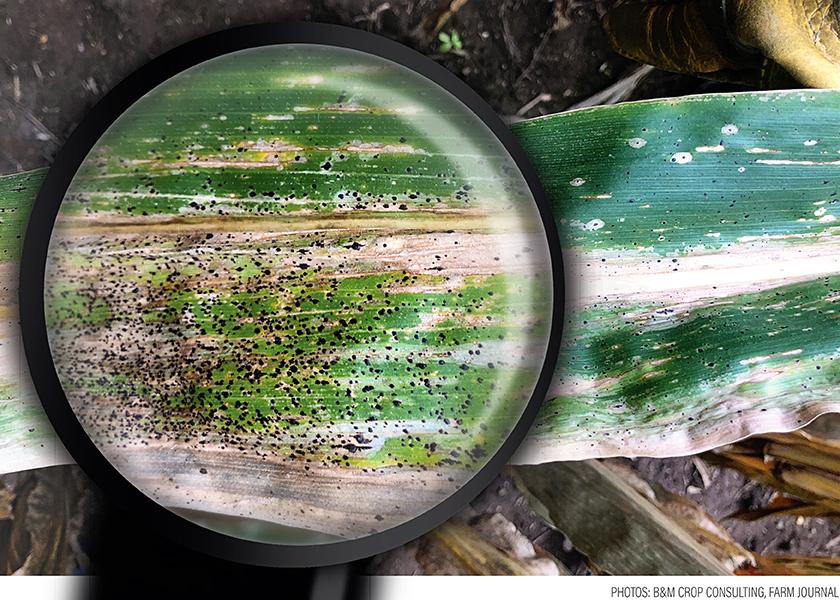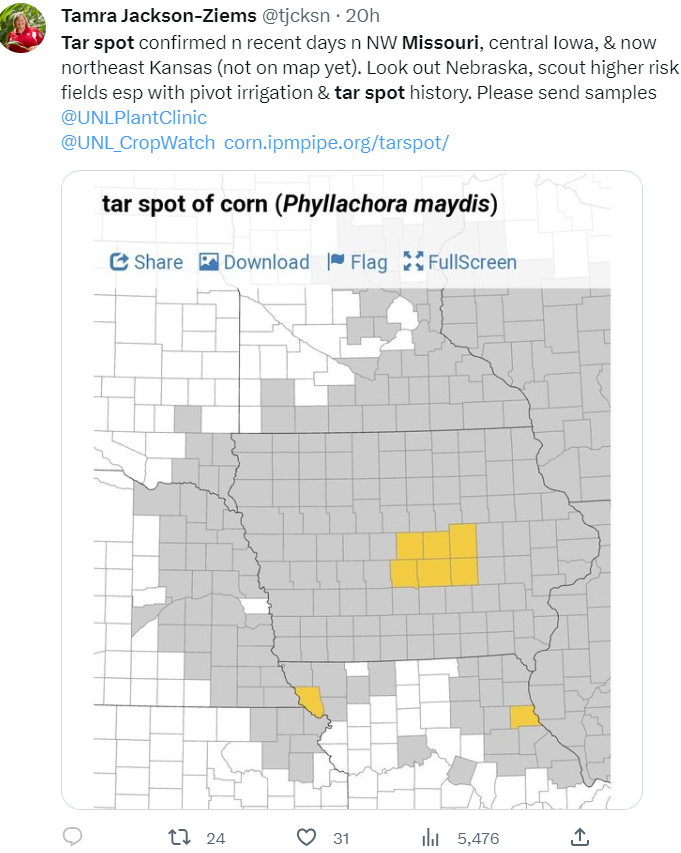Homegrown Tar Spot Is Showing Up Now Thanks To Inoculant From 2021

“Is 2023 going to be a bad year for tar spot?” That was the question an Illinois farmer recently asked Ken Ferrie, Farm Journal Field Agronomist.
It’s a question Ferrie has asked himself repeatedly the past few months. His concern: Illinois fields of corn that were hit hard by the disease in 2021 are back in corn this season for farmers in a corn-soybean rotation.
“Any fields with higher residue are going to be more susceptible to tar spot due to the fact that the inoculant was in that residue from the 2021 crop,” Ferrie contends.
This would include fields in strip till, no-till and vertical till – fields in any cultural practice that leaves more corn residue at the surface from the past crop are likely more at risk.
“Because it takes microbes about four years to completely digest a corn stalk, most likely there's tar spot inoculant in about every field now that was infected two years ago,” he contends. “I would not expect tillage or crop rotation to have done much to relieve the potential pressure for this year.”
In addition, agronomists say tar spot pressure in corn is fueled by cool (60-70 degrees F), humid conditions (>75% relative humidity) and prolonged leaf wetness (>7 hours). Therefore, tar spot pressure is typically higher in areas such as those closer in proximity to the great lakes, river bottoms and irrigated corn acres.
Early Confirmation Made In Three States
While Ferrie says the verdict is still out on what the 2023 season ultimately holds for farmers, small amounts of the disease have already been confirmed in cornfields this month in three states – Kansas, Iowa and Missouri.

“The disease was present at a very low incidence and severity in both the northwest and northeast regions of Missouri where it was found,” reports Mandy Bish, state Extension specialist in field crop pathology in a Mizzou Crop & Pest News article distributed Monday. Tar Spot of Corn – Confirmed in June - This is the earliest we’ve seen tar spot of corn in Missouri
“Now is the time to scout for the disease and monitor it,” she advises.
Homegrown Disease Is A Factor
Ferrie says there is a significant question farmers need to answer now about whether their fields are at risk from homegrown disease pressure.
“I'm asking farmers, is it in your neighborhood?” he says.
Along with that, he says to consider your weather conditions. Many parts of the Midwest that have been abnormally dry this season received some rainfall in the past week. Ferrie’s agronomic sleuthing indicates that heavy rain events can play a more significant role in homegrown infections than previously realized or understood.
“While we need climate conditions to drive the startup of tar spot infections, I believe we also need one of those hard-driving rains to splash inoculant up on the plant,” he says.

Testing A Hypothesis
Ferrie decided to test his hypothesis about hard rain events in 2022 at his agronomic campus, Crop-Tech Consulting Inc., Heyworth, Ill.
He planted a susceptible hybrid into a no-till, corn-on-corn plot that was devastated in 2021 by tar spot. He then set up sprinklers to water the corn early morning and late evening to achieve seven hours of leaf wetness.
“I never worked so hard to get a disease I didn't want,” Ferrie says, with a wry chuckle. “But in the end, tar spot did not infect the susceptible hybrid.”
With no big rains to splash the inoculant up onto the corn plants, it didn't reach a treatment threshold level in 2022.
“The conditions weren't in favor of tar spot last summer (in central Illinois), as we kind of had a flash of drought through here between June and July,” he reports.
Ferrie’s team added a sprinkler system to the plot to increase moisture levels. But even that wasn't enough to trigger a tar spot outbreak.
Just Before Canopy Is A Critical Time

“This type of rain most likely is going to be the most effective in spreading the disease if it happens right before corn rows close (canopy),” he says.
His hypothesis is the inoculant gets onto the plants, then the rows close, helping to keep the infection in the crop, and it builds from there.
“Once that homegrown tar spot gets fired up, then it can lead to the windblown tar spot that moves and reproduces much faster and doesn't need a hard-driving rain to keep it moving,” he contends.
Action Steps For Farmers Now
Ferrie asks farmers to play defense now by watching weather conditions, scouting and being prepared to make one or more fungicide applications.
Bish encourages Missouri farmers who are looking for tar spot to delay early fungicide applications. “We want to hold off on those fungicide applications a little longer,” she says. “Treatment at VT through R3 have shown the most consistent results in research on tar spot management.”
Ferrie adds that if you've been seriously scouting the past couple of years and haven't seen tar spot yet, he believes your risk of homegrown tar spot is lower, and your main threat from the disease would be from windblown spores coming in from other areas.
Consider These Additional Resources
Tar Spot Distribution map (https://corn.ipmpipe.org/tarspot/)
Tar Spotter App – https://ipcm.wisc.edu/apps/tarspotter/
Crop Protection Network – https://cropprotectionnetwork.org







